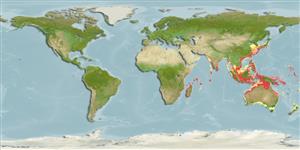Environment: milieu / climate zone / depth range / distribution range
Écologie
marin récifal; profondeur 5 - 90 m (Ref. 9710). Tropical
Indo-West Pacific: Indian Ocean to Taiwan, Philippines, Indonesia, the Arafura Sea (Ref. 9819) and Western Australia.
Taille / Poids / Âge
Maturity: Lm ? range ? - ? cm
Max length : 26.0 cm TL mâle / non sexé; (Ref. 9710)
Épines dorsales (Total) : 17 - 18; Rayons mous dorsaux (Total) : 7 - 9; Épines anales: 2; Rayons mous anaux: 11 - 13.
Occurs in inshore waters of the continental shelf (Ref. 75154). Inhabits sandy bottoms near reefs (Ref. 9710). Benthic (Ref. 75154). Anterolateral glandular grooves with venom gland (Ref. 57406). Also found in rubble and mud bottoms in 5-90 m (Ref 90102).
Life cycle and mating behavior
Maturité | Reproduction | Frai | Œufs | Fécondité | Larves
Sainsbury, K.J., P.J. Kailola and G.G. Leyland, 1985. Continental shelf fishes of the northern and north-western Australia. An illustrated guide. CSIRO Division of Fisheries Research; Clouston & Hall and Peter Pownall Fisheries Information Service, Canberra, Australia. 375 p. (Ref. 3131)
Statut dans la liste rouge de l'IUCN (Ref. 130435: Version 2024-2)
Utilisations par l'homme
Pêcheries:
Outils
Articles particuliers
Télécharger en XML
Sources Internet
Estimates based on models
Preferred temperature (Ref.
123201): 24.3 - 29, mean 27.8 °C (based on 1270 cells).
Phylogenetic diversity index (Ref.
82804): PD
50 = 0.5010 [Uniqueness, from 0.5 = low to 2.0 = high].
Bayesian length-weight: a=0.02138 (0.00903 - 0.05062), b=2.94 (2.73 - 3.15), in cm total length, based on LWR estimates for this (Sub)family-body shape (Ref.
93245).
Niveau trophique (Ref.
69278): 4.1 ±0.7 se; based on size and trophs of closest relatives
Résilience (Ref.
120179): Milieu, temps minimum de doublement de population : 1,4 à 4,4 années (Preliminary K or Fecundity.).
Fishing Vulnerability (Ref.
59153): Low vulnerability (16 of 100).
Nutrients (Ref.
124155): Calcium = 56.9 [24.4, 130.7] mg/100g; Iron = 0.581 [0.282, 1.228] mg/100g; Protein = 17.7 [16.0, 19.2] %; Omega3 = 0.176 [0.076, 0.525] g/100g; Selenium = 34.7 [18.4, 88.1] μg/100g; VitaminA = 78.7 [22.0, 288.9] μg/100g; Zinc = 1.08 [0.72, 1.62] mg/100g (wet weight);
